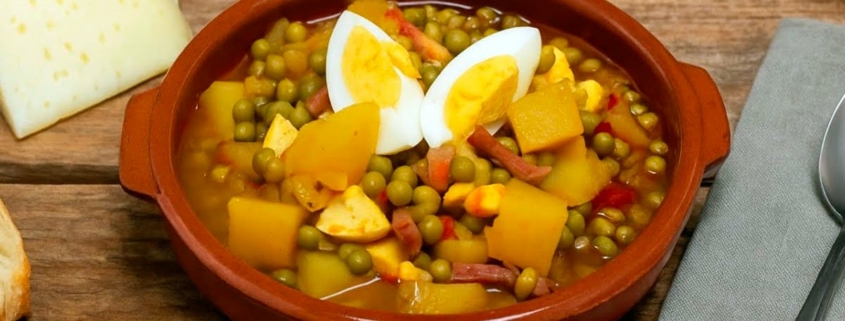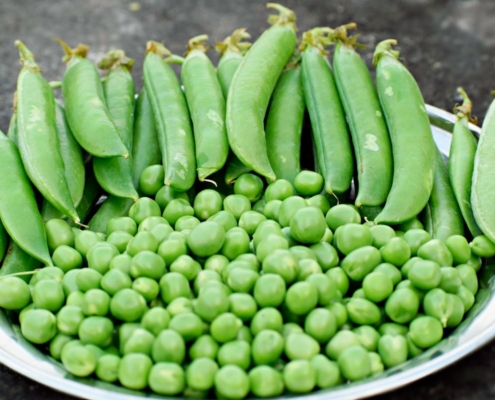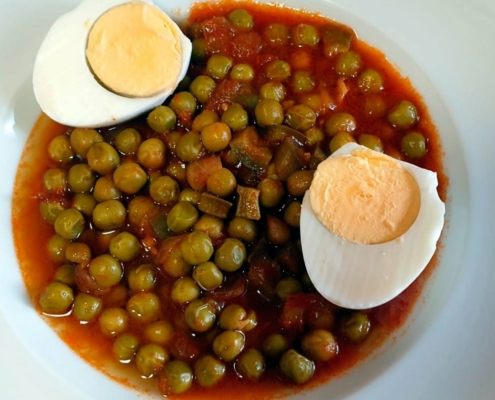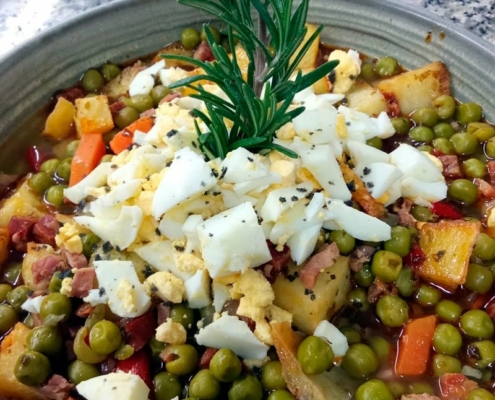
In the Canarian cuisine recipe book, there are dishes that don’t require extensive ingredients to win over the palate. One of them is compound peas , a simple, nutritious recipe rooted in the archipelago’s popular tradition.
In the Canary Islands, the term “arvejas” refers to green peas (fresh or dried). In the past, they were a common crop in small family gardens and an important source of vegetable protein in times when meat was scarce.
Origins
For much of the 20th century, peas were a common and indispensable ingredient, especially among families in the midlands, where they were grown.
The earliest versions of this dish were very basic. Rural families cooked them with whatever was available in their pantry: onions, peppers, garlic, tomatoes, and potatoes.
Over the years and with the improvement of economic conditions, the stew began to be enriched with Canarian chorizo, pork ribs, bacon or even sweet blood sausage, giving rise to the so-called compound peas.
Common ingredients in compound peas
Although there are slight variations between islands—and even between municipalities—the basic ingredients remain the same. This is the most widespread version, typical of northern Tenerife:
- 500 g of peas (peas, preferably fresh or soaked if they are dry)
- 2 medium potatoes
- 1 onion
- 1 green pepper
- 2 cloves of garlic
- 2 ripe tomatoes or a tablespoon of homemade tomato sauce
- 1 Canarian chorizo (sweet or spicy, to taste)
- A piece of salted bacon or ribs (optional)
- 1 bay leaf
- 1 teaspoon of paprika
- Extra virgin olive oil
- Salt and pepper to taste
In some homes it is accompanied with chopped hard-boiled egg, a drizzle of raw olive oil at the end or even a pinch of ground cumin, widely used in traditional Canarian cuisine.
Elaboration
- In a cauldron, sauté the chopped onion, garlic, and pepper in a dash of oil.
- Add the tomato and let it blend until it forms a thick sauce.
- Add the chorizo and bacon, cut into pieces, so that they fry lightly and release their flavor.
- Add the peas and chopped potatoes, mix everything and cover with hot water.
- Add the bay leaf, paprika, salt and pepper.
- Simmer for 45 minutes to 1 hour, until the peas are tender and the broth has thickened.
- Finally, and optionally, you can chop or slice a hard-boiled egg and place it on top of the plate of peas.
The result is a tasty and comforting stew, with just the right amount of fat and a flavor reminiscent of home and family lunches of yesteryear.
Variations by islands
Each island and each house brings its own personal touch:
- Tenerife: usually includes Canarian chorizo and potatoes, with a thick, reddish broth.
- Gran Canaria: more vegetables (carrot, red pepper) and sometimes salted ribs are added.
- La Palma: flavored with herbs such as thyme or garden herb.
- El Hierro and La Gomera: the oldest versions are vegetarian, based on peas, onions, and potatoes, with a light touch of mojo or gofio when serving.
In some homes it is accompanied with chopped hard-boiled egg, a drizzle of raw olive oil at the end or even a pinch of ground cumin, widely used in traditional Canarian cuisine.
Where to eat compound peas?
These days, it’s somewhat difficult to find compound peas. You can try them in some guachinches and Canarian food bars. Even some bars in city centers on the islands, which offer a daily menu, may occasionally make this dish.
Curiosities
- In some towns in northern Tenerife, they are simply called peas , without “compuestas,” but the term refers to when they are accompanied by meat.
- Dried peas were one of the basic products exchanged in ancient agricultural “barter” trades.
- At popular festivals and pilgrimages, this dish is still prepared in large cauldrons to be shared among neighbors.
More images



